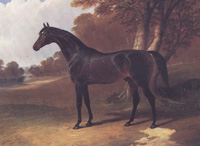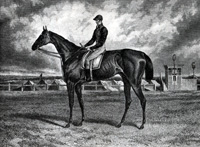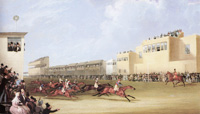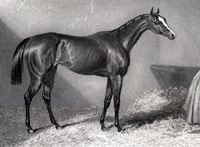

Courtesy of Richard Green Gallery


Highflyer
Sire

Partisan

Courtesy of Richard Green
Ascot Gold Cup, 1834

Refraction, by Glaucus
Bred by William Lowther (1787-1872), 2nd Earl of Lonsdale, who was known by the courtesy title of Viscount Lowther from 1807 to 1844 when he succeeded his father as 2nd Earl, Glaucus was a full brother to the July Stakes winner Berwickshire (b c 1833). Viscount Lowther also bred the St Leger winner Ambrosio (b c 1793 Sir Peter Teazle), the Two Thousand Guineas winner Nicolo (ch c 1820 Selim) and the One Thousand Guineas winner Zoe (b f 1825 Orville). Mr Stephenson purchased Glaucus for 300 guineas as a yearling and sold him on to General Thomas Grosvenor (1764-1851), nephew of Richard, 1st Earl Grosvenor, for 350 guineas. General Grosvenor also bred the Oaks Stakes winners Briseis (b f 1804 Beningbrough), Corinne (br f 1815 Waxy) and Wings (ch f 1822 The Flyer). Glaucus was purchased by Mr Ridsdale for 3000 guineas after he defeated Clearwell in a match in 1832 and by the Earl of Chesterfield for 1700 guineas after his loss in the St Leger of 1833. George Stanhope (1805-1866), 6th Earl of Chesterfield, was a turf enthusiast of some magnitude having bred the splendid Two Thousand Guineas, One Thousand Guineas and Oaks winner Crucifix (b f 1837 Priam) and the Oaks winners Industry (br f 1835 Priam) and Lady Evelyn (b f 1846 Don John). His racing stable was managed Charles Greville at Newmarket until 1832 when John Scott took over and the horses were sent to Malton.
Described as a bay standing nearly 16 hands he was said to have lengthy proportions and although "perhaps too attenuated in form to please the eyes of some" that "on closer inspection he is a fine specimen of lightness and symmetry, combined with great muscular structure, indicative of agility and strength".
Glaucus ran for five years with considerable success excepting his year with Mr Ridsdale when victory eluded him completely. Despite his promising form as a two year old and starting favourite for the Derby the closest he came to classic success was his sixth place finish for the St Leger. Following his purchase by Lord Chesterfield and in the capable hands of John Scott his four year old season saw him return to form. He won the Gold Cup at Ascot, defeating the St Leger winner Rockingham (b c 1830 Humphrey Clinker), and the Eclipse foot the same day although the latter was said to have been run in a fairly leisurely fashion until the end was in sight. He won the Goodwood Cup as a five year old and as a six year old he appeared for his engagements but after competition failed to materialise he retired from the turf.
At stud in England he sired the One Thousand Guineas Stakes winner Pic-Nic (b f 1842), the Oaks Stakes winner Refraction (br f 1842) the latter the dam of the Grosser Preis von Baden winner La Maladetta (b f 1855 The Baron) the latter in turn the dam of the Grosser Preis von Baden winner Cerdagne (b f 1866 Newminster), the Woodcote Stakes winner Palaemon (br c 1838), the stallion The Nob (b c 1838), Forest Flower (b f 1842) the dam of the stallion King of the Forest (b c 1854 Orlando), Lena (ch f 1842) the dam of the Manchester Cup winner Pretty Boy (ch c 1853 Idle Boy), Glaucus Mare (ch f 1842) the second dam of the One Thousand Guineas winner Hester (b f 1867 Thormanby) and the Prince of Wales's Stakes winner The Avenger (b c 1860 Vindex) as well as the third dam of the Two Thousand Guineas winner Prince Charlie (ch c 1869 Blair Athol) and the Royal Hunt Cup winner Thuringian Prince (ch c 1871 Thormanby) and Hersey (b f 1842) the second dam of the Goodwood Cup winner The Duke (b c 1862 Stockwell)), the Nassau Stakes winner Duchess (br f 1864 St. Albans) and the Grand Prix de Paris winner The Earl (b c 1865 Young Melbourne). Glaucus was sent to Prussia after the season in 1843 joining the stud of Graf Hahn-Basedow at Mecklenburg. There he got the Mehl-Mülhens-Rennen and Union-Rennen winner Meridian (ch c 1845), the Union-Rennen winner Achaja (b f 1846), the Mehl-Mülhens-Rennen winner Equator (ch c 1848) and Brown Bess (bf f 1847) the second dam of the Preis der Diana winners Lady Bird (ch f 1866 King of Diamonds) and Caro Dame (b f 1867 King of Diamonds).
| Glaucus | Partisan | Walton | Sir Peter Teazle |
| Arethusa | |||
| Parasol | Pot8os | ||
| Prunella | |||
| Nanine | Selim | Buzzard | |
| Alexander Mare | |||
| Bizarre | Peruvian | ||
| Violante |
In 1833 running for Mr Ridsdale he collected a forfeit from Lord Chesterfield's Elvaston (b c 1830 Sultan) and from Lord Exeter's Mountebank colt at Newmarket Craven after which he failed to place in either the Derby in which he started as the favourite or the St Leger in which he finished sixth, won by Mr Sadler's Dangerous and Mr Watt's Rockingham (b c 1830 Humphrey Clinker) respectively.
In 1834 running for Lord Chesterfield he won the 200 sovs each Claret Stakes at Newmarket Craven beating the Duke of Rutland's Shylock (b c 1830 Waterloo) by 2 lengths, Mr Houldsworth Titus (ch c 1830 Truffle) and Lord Exeter's Cactus (br c 1830 Sultan), lost a 200 sovs match at the same meeting to Mr Osbaldeston's The Saddler (br c 1828 Waverley) by half a length, won the Gold Cup at Ascot beating Mr Theobald's (formerly Mr Watt's) Rockingham, Sir Gilbert Heathcote's Samarcand (ch c 1830 Blacklock), Mr Watt's Belshazzar (ch c 1830 Blacklock)), Mr Greville's Chantilly (ch f 1830 Gustavus) and five others, won the Eclipse Foot and 200 sovs added by HM the same day beating Mr Cosby's Doncaster Cup winner Galopade (bl c 1828 Doctor Syntax) by 5 lengths, walked over at Goodwood for the King's Purse, finished 2nd for the 100 sovs each Garden Stakes at Newmarket Second October to Lord Jersey's Two Thousand Guineas and Ascot Gold Cup winner Glencoe (ch c 1831 Sultan) beating Lord Chesterfield's Chester Cup winner Colwick (b c 1828 Filho da Puta), challenged for The Whip and in the absence of competition collected it.
In 1835 he finished 4th for the Craven Stakes at Newmarket Craven won by Mr Batson's Derby winner Plenipotentiary (ch c 1831 Emilius), won the 25 sovs each Goodwood Stakes at Goodwood beating C F Greville's One Thousand Guineas winner Preserve (ch f 1832 Emilius) and eleven others, finished 2nd for the Gold Cup at the same meeting won by Rockingham, finished 2nd for the Doncaster Stakes at Doncaster to the Duke of Cleveland's Muley Moloch (br c 1830 Muley), won the Hornby Castle Stakes at the same meeting beating Muley Moloch who broke down and one other.
In 1836 he walked over for a 50 sovs purse at Newmarket First Spring, walked over for a second fifty the following day and then retired from the turf.